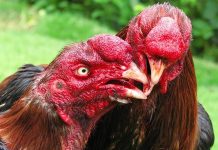In the realm of poultry, one bird stands out as an enigmatic marvel—the Ayam Cemani. Originating from the lush landscapes of Indonesia, particularly Java, this striking chicken variety possesses an allure unlike any other. What makes these birds so captivating is their complete and utter blackness. From feathers to flesh, even down to their very bones, Ayam Cemani exude an almost mystical darkness that has fascinated breeders, scientists, and enthusiasts alike.
Origins and Cultural Significance
The history of Ayam Cemani is steeped in tradition and myth. Indigenous to Indonesia, these birds have long been intertwined with local folklore and cultural beliefs. Revered for their distinctive appearance, they are often associated with spiritual significance, believed to bring luck and prosperity to those who possess them. In some parts of the country, they are utilized in mystical rituals, earning them a revered status among locals.
The Fascination with Blackness
What sets Ayam Cemani apart is their unparalleled melanistic pigmentation. Their feathers, skin, muscles, organs—virtually every part of their anatomy—is shrouded in an intense black hue. This unique trait is a result of a genetic condition known as fibromelanosis, which causes hyperpigmentation due to an overproduction of melanin.
Breeding and Rarity
Breeding Ayam Cemani involves meticulous care and selective mating to preserve their distinct genetic traits. Due to their rarity and unique appearance, these birds are highly sought after by collectors, poultry enthusiasts, and individuals fascinated by their extraordinary black beauty. However, their breeding and maintenance require expertise and attention to detail, contributing to their exclusivity and higher market value.
Global Appeal and Recognition
Beyond Indonesia’s borders, Ayam Cemani have garnered attention for their exotic appearance and rarity. They have found their way into the collections of poultry breeders worldwide, captivating audiences with their striking presence. Their allure extends beyond ornamental purposes; some breeders have explored their potential for sustainable meat production, despite their relatively smaller size compared to conventional chicken breeds.
Challenges and Care
While Ayam Cemani possess an undeniable allure, their unique genetic makeup presents challenges. Careful husbandry is essential to maintain their health and preserve their distinctive traits. Ensuring proper nutrition, shelter, and protection from potential health issues associated with their genetics is crucial for their well-being.
Conclusion
The Ayam Cemani stands as a living testament to nature’s extraordinary creations. Its mysterious blackness, rooted in genetics and cultural significance, continues to captivate and intrigue individuals worldwide. Whether viewed as a symbol of mysticism or appreciated for their ornamental beauty, these remarkable chickens remain a testament to the marvels found within the diverse world of avian species.
In the end, Ayam Cemani stands not just as a breed of chicken but as a symbol—a symbol of cultural heritage, genetic uniqueness, and the inexplicable allure of the natural world.











